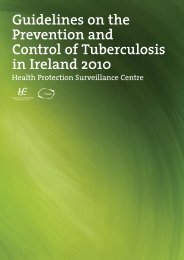Guidelines for the Early Clinical and Public Health Management of ...
Guidelines for the Early Clinical and Public Health Management of ...
Guidelines for the Early Clinical and Public Health Management of ...
Create successful ePaper yourself
Turn your PDF publications into a flip-book with our unique Google optimized e-Paper software.
<strong>Guidelines</strong> <strong>for</strong> <strong>the</strong> <strong>Early</strong> <strong>Clinical</strong> <strong>and</strong> <strong>Public</strong> <strong>Health</strong> <strong>Management</strong> <strong>of</strong> Bacterial Meningitis (including Meningococcal Disease)<br />
attend <strong>the</strong> same pre-school, school or college as a case <strong>of</strong> IMD The expert group reviewed <strong>the</strong> available evidence<br />
<strong>and</strong> made a weak recommendation that: “Attending <strong>the</strong> same pre-school as a case <strong>of</strong> IMD is an indication <strong>for</strong><br />
chemoprophylaxis, depending on risk assessment” (ECDC). They also concluded that a risk assessment in <strong>the</strong> preschool<br />
setting that takes into account duration <strong>and</strong> closeness <strong>of</strong> contact may assist decision making. “The risk <strong>of</strong><br />
fur<strong>the</strong>r cases is considered higher in settings similar to households where <strong>the</strong>re would be a higher risk <strong>of</strong> exposure to<br />
respiratory droplets. Children in <strong>the</strong> same group as <strong>the</strong> index case who have spent long periods <strong>of</strong> time in <strong>the</strong> same<br />
room (e.g. fulltime attendance, sharing meals, napping toge<strong>the</strong>r) are likely to be at higher risk than children in a<br />
different group or with contact to <strong>the</strong> index case that is less direct (e.g. free play versus fixed seating) or <strong>of</strong> shorter<br />
duration (e.g. part-time attendance).” 2<br />
The Australian guidance on public health management <strong>of</strong> meningococcal disease recommends chemoprophylaxis<br />
<strong>for</strong> contacts in “child care involving a group staying toge<strong>the</strong>r in a single room <strong>for</strong> a four-hour session” 1<br />
Recommendation chemoprophylaxis <strong>for</strong> pre-school contacts<br />
Attending <strong>the</strong> same pre-school as a case (child or staff) <strong>of</strong> IMD is an indication <strong>for</strong> chemoprophylaxis,<br />
depending on risk assessment.<br />
Following risk assessment chemoprophylaxis should be considered (<strong>for</strong> children <strong>and</strong> staff) in <strong>the</strong><br />
following circumstances:<br />
• Family pre-school daycare (where groups <strong>of</strong> children are cared <strong>for</strong> in a private home), during <strong>the</strong><br />
seven days be<strong>for</strong>e onset <strong>of</strong> illness.<br />
• Pre-school childcare involving a group staying toge<strong>the</strong>r in a single room <strong>for</strong> at least a four-hour<br />
session, during <strong>the</strong> seven days be<strong>for</strong>e onset <strong>of</strong> illness.<br />
• Pre-school childcare involving a group staying toge<strong>the</strong>r in a single room <strong>for</strong> at least a threehour<br />
session on more than one day, during <strong>the</strong> seven days be<strong>for</strong>e onset <strong>of</strong> illness. In this situation,<br />
chemoprophylaxis may be considered if <strong>the</strong> setting is similar to a household, e.g. if <strong>the</strong> children share<br />
meals <strong>and</strong> nap toge<strong>the</strong>r.<br />
7.3.3 Primary or secondary schools contacts <strong>of</strong> a case<br />
The ECDC guidance document – <strong>Public</strong> <strong>Health</strong> <strong>Management</strong> <strong>of</strong> Sporadic Cases <strong>of</strong> Invasive Meningococcal Disease<br />
<strong>and</strong> <strong>the</strong>ir Contacts 2 reviewed <strong>the</strong> evidence <strong>and</strong> concluded that <strong>the</strong> risk difference was much higher in pre-school<br />
settings than in school settings. The report states that “if chemoprophylaxis in educational settings was as effective<br />
in risk reduction as in households, <strong>the</strong> number <strong>of</strong> contacts that would need to be treated to prevent one subsequent<br />
case based on <strong>the</strong> studies analysed in this review would vary from 1,930 (95%CI 1,262-4,116) in pre-school settings<br />
to 27,405 (95%CI 19,372-48,851) in school settings, compared to a pooled estimate <strong>of</strong> 304 in household settings<br />
(95%CI 89-564).” The expert group reviewed <strong>the</strong> available evidence <strong>and</strong> made a weak recommendation that<br />
“Attending <strong>the</strong> same school/college (including <strong>the</strong> same class) as a case <strong>of</strong> IMD is not in itself an indication <strong>for</strong><br />
chemoprophylaxis”. 2<br />
Recommendation regarding chemoprophylaxis in schools<br />
• Chemoprophylaxis is not routinely recommended <strong>for</strong> class contacts <strong>of</strong> a single case in primary or<br />
secondary school, unless <strong>the</strong>y fit criteria <strong>for</strong> close contacts.<br />
7.3.4 Universities (or o<strong>the</strong>r tertiary education facilities) contacts <strong>of</strong> a case<br />
Although <strong>the</strong> incidence <strong>of</strong> meningococcal disease in college students in <strong>the</strong> United States does not seem to be<br />
greater than that in <strong>the</strong> general population <strong>of</strong> <strong>the</strong> same age 55 this is not <strong>the</strong> situation in <strong>the</strong> United Kingdom where<br />
<strong>the</strong> incidence is certainly greater in university students. 56 In <strong>the</strong> latter study, disease rates were shown to be highest<br />
in students, <strong>of</strong>ten in <strong>the</strong>ir first year, living on campus.<br />
The absolute risk <strong>of</strong> a university or college student in Engl<strong>and</strong> <strong>and</strong> Wales becoming a case in <strong>the</strong> month after <strong>the</strong><br />
diagnosis <strong>of</strong> an index case in <strong>the</strong> same university or college has been found to be very low. 46<br />
-59-

















